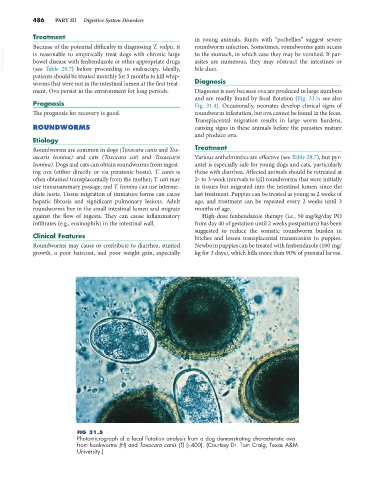Page 514 - Small Animal Internal Medicine, 6th Edition
P. 514
486 PART III Digestive System Disorders
Treatment in young animals. Runts with “potbellies” suggest severe
Because of the potential difficulty in diagnosing T. vulpis, it roundworm infection. Sometimes, roundworms gain access
VetBooks.ir is reasonable to empirically treat dogs with chronic large to the stomach, in which case they may be vomited. If par-
asites are numerous, they may obstruct the intestines or
bowel disease with fenbendazole or other appropriate drugs
bile duct.
(see Table 28.7) before proceeding to endoscopy. Ideally,
patients should be treated monthly for 3 months to kill whip-
worms that were not in the intestinal lumen at the first treat- Diagnosis
ment. Ova persist in the environment for long periods. Diagnosis is easy because ova are produced in large numbers
and are readily found by fecal flotation (Fig. 31.5; see also
Prognosis Fig. 31.4). Occasionally, neonates develop clinical signs of
The prognosis for recovery is good. roundworm infestation, but ova cannot be found in the feces.
Transplacental migration results in large worm burdens,
ROUNDWORMS causing signs in these animals before the parasites mature
and produce ova.
Etiology
Roundworms are common in dogs (Toxocara canis and Tox- Treatment
ascaris leonina) and cats (Toxocara cati and Toxascaris Various anthelmintics are effective (see Table 28.7), but pyr-
leonina). Dogs and cats can obtain roundworms from ingest- antel is especially safe for young dogs and cats, particularly
ing ova (either directly or via paratenic hosts). T. canis is those with diarrhea. Affected animals should be retreated at
often obtained transplacentally from the mother; T. cati may 2- to 3-week intervals to kill roundworms that were initially
use transmammary passage, and T. leonina can use interme- in tissues but migrated into the intestinal lumen since the
diate hosts. Tissue migration of immature forms can cause last treatment. Puppies can be treated as young as 2 weeks of
hepatic fibrosis and significant pulmonary lesions. Adult age, and treatment can be repeated every 2 weeks until 3
roundworms live in the small intestinal lumen and migrate months of age.
against the flow of ingesta. They can cause inflammatory High-dose fenbendazole therapy (i.e., 50 mg/kg/day PO
infiltrates (e.g., eosinophils) in the intestinal wall. from day 40 of gestation until 2 weeks postpartum) has been
suggested to reduce the somatic roundworm burden in
Clinical Features bitches and lessen transplacental transmission to puppies.
Roundworms may cause or contribute to diarrhea, stunted Newborn puppies can be treated with fenbendazole (100 mg/
growth, a poor haircoat, and poor weight gain, especially kg for 3 days), which kills more than 90% of prenatal larvae.
T
H
H
FIG 31.5
Photomicrograph of a fecal flotation analysis from a dog demonstrating characteristic ova
from hookworms (H) and Toxocara canis (T) (×400). (Courtesy Dr. Tom Craig, Texas A&M
University.)

